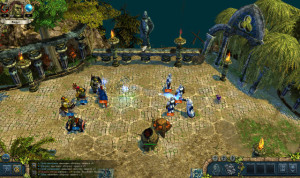Game Design: Puzzle-Solving vs. Problem-Solving
Posted by Rampant Coyote on December 28, 2015
 Many types of games emphasize puzzle-solving. Adventure games, hidden-object games, and many popular indie platformer games come to mind (Super Meat Boy being one of the best examples).
Many types of games emphasize puzzle-solving. Adventure games, hidden-object games, and many popular indie platformer games come to mind (Super Meat Boy being one of the best examples).
For me, puzzle-solving is overcoming a problem for which there is a narrow range (often only one) solution, or a “best” solution. The challenge may be in solving the puzzle, executing on the solution, or both. The emphasis here is on coming up with the “correct” solution (or one of a couple of variants).
Problem-solving is similar, but the core concept is fundamentally different. It’s way more loosy-goosey and open-ended. While there may be more optimal strategies than others, a problem-solving challenge is one in which there is not a well-defined solution.
 Most games incorporate some kind of problem-solving elements in them, but some genres make that more of a focus. Strategy / tactics games and role-playing games – particularly turn-based RPGs – come to mind. Boss battles in good action games tend to take this approach.
Most games incorporate some kind of problem-solving elements in them, but some genres make that more of a focus. Strategy / tactics games and role-playing games – particularly turn-based RPGs – come to mind. Boss battles in good action games tend to take this approach.
These are both great kinds of gameplay, but as a general rule, they don’t usually go well together. This isn’t to say you can’t mix the puzzle-solving into a problem-solving-focused genre or vice versa. It’s been done many times. In fact, you could come up with a very interesting game concept that way. Portal is an example – kind-of – turning what feels like a first-person shooter into a puzzle game. It can work if the entire game is designed around that focal change. Lightly mixing one element into the other may also work, but this has to be done with care. I remember some adventure games in the 1990s nearly ruined by the introduction of little action-sequences and whatnot. Many (most?) RPGs have some smaller, simpler puzzle elements that work well to add variety to the game, but enjoyment can be brought to a screeching halt by the introduction of a too-difficult mandatory puzzle sequence.
It’s like pizza and ice cream. I may enjoy them both a great deal separately, but I have less than zero interest in pizza-flavored ice cream.
It’s one of many problems with “kitchen sink” game design. The key is – as with everything in game design – understanding the “core” of the game and adding elements that accentuate that core rather than detracting from it.
Filed Under: Design - Comments: 4 Comments to Read
Tesh said,
Advance Wars on the GBA has an interesting mix. Some levels are clearly problems to solve, with bases to build more units, while others are far more puzzle-like, with constrained resources. The core tactical gameplay is solid enough to work for both; it’s just a matter of level design.
Maklak said,
> “kitchen sink” game design.
Hehe. They often make some sub-system of a game into a minigame that is completely different than the rest of the game, but offers some rewards. Lockpicking and hacking in RPGs often end up as this. I’ve aslo seen a game about running a shipping company where you can play a minigame to dock / leave port or pay to call a tug and skip it. I don’t like minigames in general, especially if they require completely different skills then the rest of the game.
Rampant Coyote said,
@Tesh – You sometimes get those in some RTS games now. It’s not purely puzzle-like… there are clear variations… but you cannot wind unless you confine yourself to a pretty narrowly defined order of actions.
Those are almost always my least favorite levels. 😛 Although I know me… as a game designer I might forget how much those annoy me and do the same thing. I always have to watch myself for committing the same sins I rail against w/ others.
@Maklak: The worst are the mini-games (and especially quick-time actions, which really are mini-games at their heart… like “Simon Says” to not lose the game) which have absolutely zero to do with the underlying game systems. Like you could have a character with the reflexes and speed of The Flash yet it makes zero impact on your timed, reflex-based mini-game.
Noumenon72 said,
This explains why out of the two games I tried from the Steam Sale, I quit The Talos Principle and am loving Valkyria Chronicles. The Talos Principle was cool, but I knew whatever I did in each level would be “wrong” because I wouldn’t figure out where that one missing star was, and there’s only one right way to solve each puzzle. Valkyria Chronicles, on the other hand, requires you to win each battle in a certain number of rounds but I can do it with any combination of orders and units. And even if I don’t figure out the perfect combination, I can still “win” a bit more slowly. So I always feel good instead of bad.